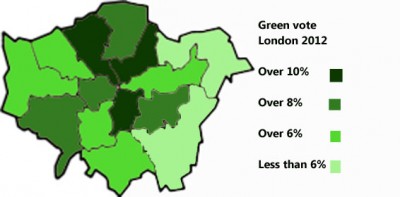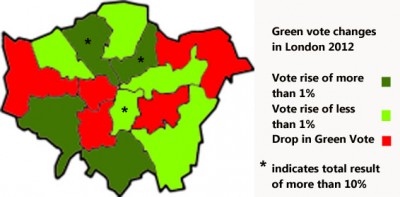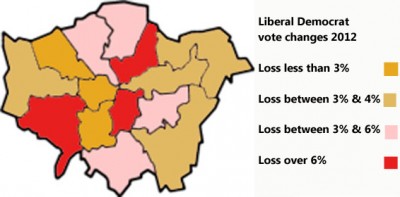The Green Party achieved an incredible result on Thursday. In a city the size of London it is no mean feat for a minor party with just two councillors to come third place.
Although Greens will be disappointed that both they and the Lib Dems have an equal number of Assembly Members it is still a cause for celebration in the Green camp, and a body blow for the Liberal Democrats. The Greens would have needed 10.02% on the list to gain a third seat, a rise of 1.48% from their 8.54%.
In the Mayoral race the Greens significantly increased their first preferences bringing their vote more closely in line with the Assembly vote on a ballot paper where they have traditionally under performed. However, while second preferences for the Greens had no practical effect it must be heartening to know that over 20% of Londoners who voted placed a cross in the box for the Greens either first or second preference. This may well speak to the level of potential support the Greens may be able to win in future elections.
Moving forwards?
One area of potential disappointment, hidden by the third place headlines, is that the list vote only fractionally increased from 2008. Roughly the same number of Londoners gave the Green list their support as last time, yet the headlines are far better due to the Lib Dem collapse.
Before drawing too many conclusions to this it’s worth bearing in mind some political context. Although the Greens moved forwards this was potentially a very difficult election for them. Conventional wisdom says that people don’t vote Green in a recession, and we’re in the second dip of ours. It’s also clear that the Labour vote is rising tidally which, for the Greens, could be potentially damaging as they tend to draw their vote from the left, who could have deserted the Greens for the more “credible” opposition of Labour – but didn’t.
Without wanting to sound like a spin doctor, a small rise in a difficult election is actually quite an achievement, just as those Lib Dems who managed to shore up their vote have achieved something considering the national context.
Mapping the election
For the purposes off this exercise we’re only going to look at the Constituency votes for the Greens, in order not to over complicate the figures (see boring methodological note below). First let’s map the raw Green vote. Darkest areas are “best”, lightest the “worst”.

Here we see that North East (Hackney and Islington), Barnet and Camden, and Lambeth and Southwark all polled more than 10% across each constituency making them the areas of strongest Green support. It may not be a surprise that Havering and Redbridge and Bexley and Bromley were the least fertile areas in London for the Greens.
Havering and Redbridge was the only constituency where the Greens lost their deposit. That may not sound like much but, for a smaller party, retaining those deposits is crucial.
When we start looking at the trends in voting pattern something interesting begins to emerge. Red is a downwards shift, dark green are the largest increases. Again these are the constituency results.
Of 14 constituencies the Green vote actually declined in five areas, some strong, some weak. Given the extra 1.48% on the list required for a third seat a more consistent performance across London would, possibly, have gained that third seat.
I was expecting to see a stronger division between “outer and “inner” London, which did not materialise. I’m putting this down to the effect of increased television coverage, although perhaps I was just wrong to expect it.
The strongest correlation appears to be with the Liberal Democrat performance.
Across the constituencies where the Greens saw the largest gains the Liberal Democrats saw the largest losses, and where the Greens lost votes these were, with just one exception, the areas where the Liberal Democrats were able to keep their vote together most effectively.
While you can draw your own conclusions as to why that correlation might be taking place (which could be entirely independent of both parties) it should highlight that, unsurprisingly, a lot of the results depended on political trends rather than specific candidates, or campaigns which can be unfairly swept away or rewarded due to factors outside of their control.
Overall
Again a good result for the Greens, in line with their modest improvements nationally, but this result was not across the board. The boost they required to win an extra AM was modest, but not insignificant (and would have been won at the expense of the Liberal Democrats). So while they very well they were a little way off improving the number of elected representatives overall.
Boring methodological note: the categories chosen for the maps are, to some extent, arbitrary. However they were chosen partly to aid the visualisation of certain trends. These maps would look (a little) different if Mayoral or list votes were used instead, but the broad categories would be approximately the same and rather than experiment with different data to emphasise certain conclusions it seemed more ethical to use one set of data and stick to it.





4 Comments
You say ‘Conventional wisdom says that people don’t vote Green in a recession, and we’re in the second dip of ours’ but maybe our policies on fair pay reducing inequality and on housing and jobs’ made an impression finally, as we are being seen for what we are: a social justice and equality party in conjunction with the environment.
You could well be right. What’s certainly the case is that the Greens performed well in a situation when we’re told they should be doing badly.
I think it shows that we’re either seen nationally as a party that doesn’t just stand for the environment, or it shows that we’re really good at winning local elections. I have a feeling it may be the latter rather than the former, but it could easily be a combination of the two. What we haven’t seen in the last two elections is a region that is undergoing both a national/regional election at the same time as having a local election. Back in 2010 when the General election and the London local elections coincided we saw quite large defeats because the Labour vote turned out. This time the regional election was in London but there were no local elections, however next year the Euros will coincide with any locals (when UKIP will no doubt have a big boost to their results), so it will be a test of whether our good local campaign reflects well on us nationally.
The Euros (and London’s local elections) are in 2014, not next year. Bu you’re definitely right that the London local results in 2010 (like other large cities) was a disaster for the Greens purely because the two elections cashed.